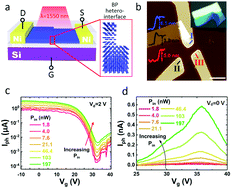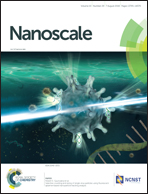Tunable black phosphorus heterojunction transistors for multifunctional optoelectronics†
Abstract
Many, black phosphorus (BP) based field-effect transistors, homojunctions, and vertical van der Waals structures have been developed for optoelectronic applications, with few studies being conducted on exploring the potential of their naturally formed heterojunctions. Here, we report a novel thickness-modulated, gate-tunable BP heterojunction phototransistor for multiple purposes and high performance optoelectronics. Despite its thickness of less than 5 nm, the device, whose fabrication spares the need for split-gate or chemical doping or vertical stacking requirements, achieves an excellent photoresponsivity of 383 A W−1 at 1550 nm under zero gate bias, which is among the best photoresponse performance of all-BP-based photodetectors in this spectral range. Furthermore, it exhibits a shot-noise-limited noise equivalent power (NEPshot) of less than 10−2 pW Hz−1/2, making it very promising for ultra-low power detection. Additionally, owing to the heterojunction-induced built-in electric field, the device can be readily used for infrared photovoltaic devices in the absence of source–drain bias (Vd), a feature that is distinctively superior to traditional phototransistors. The multifunctionality demonstrated in our BP heterojunction transistor paves the way towards realizing tunable improved performance optoelectronics based on 2D materials platform.



 Please wait while we load your content...
Please wait while we load your content...